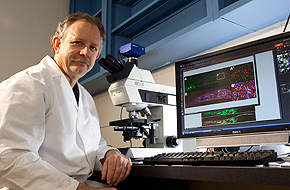By John C. Giardina
Imagine living in a society where credit cards and ID cards are obsolete. All that is needed to make a purchase is a fingerprint. That may sound a long way off, but Dr. Mehdi Daneshpanah, a UConn Ph.D. alumnus, is hard at work making that future a reality. Dr. Daneshpanah, who now works at GE Global Research, is currently working on an array of projects designed to produce cutting edge technologies that can change the ways we live.
While pursuing his doctorate, Dr. Daneshpanah, who graduated in 2010, was advised by Board of Trustees Distinguished Professor Dr. Bahram Javidi of Electrical & Computer Engineering, a leading expert in three-dimensional imaging. He began at GE Global Research this past fall and has used his expertise to research 3D measurements, working to develop new optical technologies. “I am developing these techniques to address challenging problems that arise in advanced manufacturing, materials characterization, and biometrics, to name a few areas,” he said.
One of these technologies is contactless 3D fingerprint imaging. While fingerprint identification technologies have been around for over a hundred years, these have largely involved 2D fingerprinting, according to Dr. Daneshpanah. He commented that, “It is time for a change.” The 2D scanning technologies available now require that the scanners be cleaned regularly and that consistent and constant pressure is applied when the print is being taken. A touchless 3D scanner, however, would not have these constraints; instead, some sort of 3D measurement could be taken of the finger, making the process quicker and easier. Dr. Daneshpanah is working to design a device that can make such measurements and be deployed across the world for any application that requires individual identification.
Dr. Daneshpanah is also working on a technology to accelerate the growth of the wind energy sector. Wind energy presents an important opportunity to reduce dependence on fossil fuels and lower output of greenhouse gases. There are, however, problems that arise when manufacturing the turbines to capture the energy. One such problem is the possible presence of invisible defects under the surface the blades. When defective blades are installed, the results can be disastrous, destroying thousands of dollars of equipment and interruption in service. To counter this problem, Dr. Daneshpanah is evaluating tools to quickly detect and measure these defects before the blades are installed. This capability would reduce the overall cost and production time of the turbines, encouraging the progress of an important alternative energy.
Dr. Daneshpanah credits UConn with encouraging and developing his abilities as an engineer. “Every time I look back, I realize that UConn was indeed a rich and worthwhile experience,” he said. He described one experience with his advisor, Dr. Javidi, which exemplifies the atmosphere at UConn that encourages professional growth. He recalled that he was stuck on a problem and approached Dr. Javidi, explaining that he thought it was impossible to solve. “After presenting my argument, which I thought was completely sound at the time, he reminded me that we were not trying to break any laws of physics and we may just need to adjust our mindset. That simple, very true argument changed the way I was looking at the problem and a solution was found shortly after. This was my paradigm shift from a user of knowledge to its producer – and I owe that to my advisor, Professor Javidi.”
While at UConn, Dr. Daneshpanah was consistently recognized for his research, winning multiple awards, including the IEEE Lasers & Electro-Optics Society Graduate Student Fellowship Award. After completing his degree, Dr. Daneshpanah was faced with a choice as he began his professional career. He had to decide between continuing in academia and seeking a university position or switching to research in industry. Most graduate students, at some point, are faced with a similar decision, and many may view it as a choice between two extremes. Dr. Daneshpanah, however, thinks differently and said his experience in industry is just as rewarding as it was at UConn. “I always tend to think of research as having a spectrum rather than the two academic and industrial states,” he said. “In my experience, a high impact and rewarding research is the one that strikes the right balance between the discovery and practicality faces of research. Everyone will find a sweet spot in the spectrum and will contribute to the overall advancement of science and improving life.”
Though his career is still unfolding, it is clearly one to which rising engineers and graduate students can aspire. A curious and imaginative researcher, he excelled as a student and has now jumped headfirst into some of the most exciting and important problems of our time.



